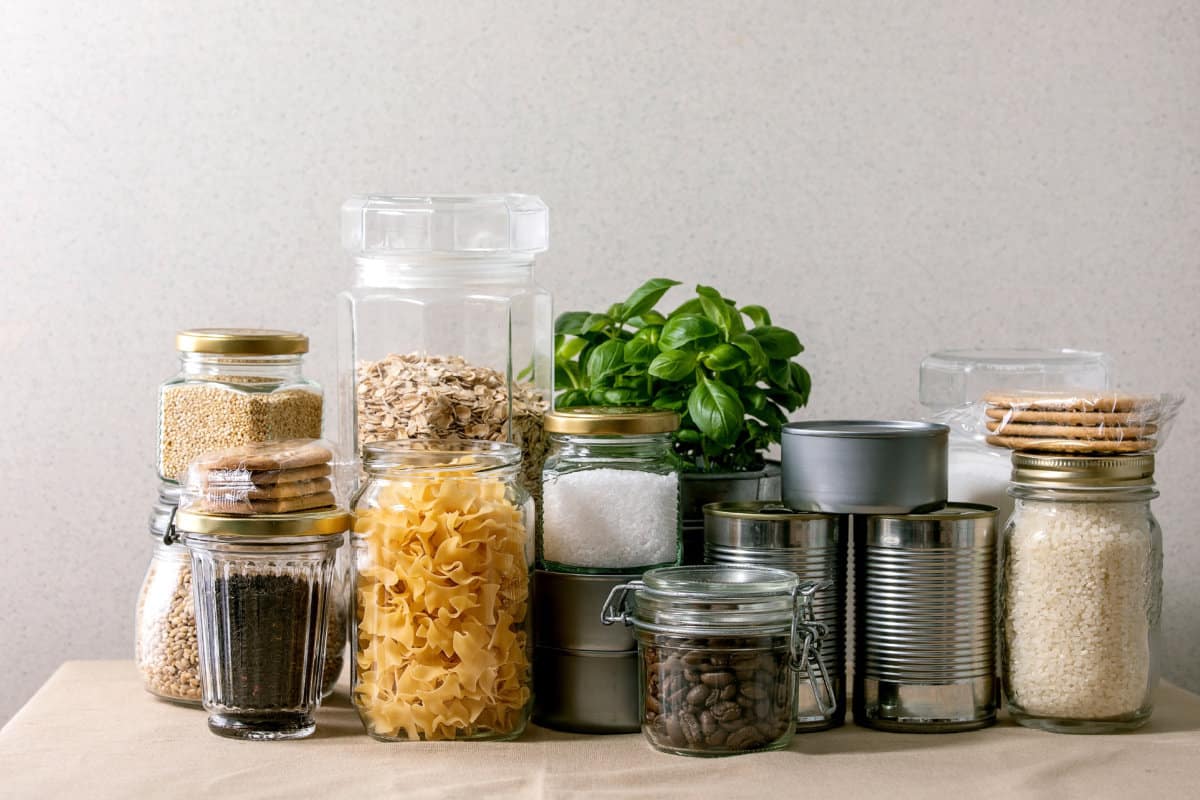
With a family of 6 and living in a rural area, I often buy basic grocery staples bulk or stock up for at least a few weeks at a time.
It not only helps us to save money, it helps us to shop less frequently which saves time and stress.
Whether you have a big family or not, there may be times you want to stock up on groceries, but aren’t sure what to buy.

I’m going to share my list of pantry and freezer essentials that I like to have on hand.
I’ll look for items from this list on the weekly grocery circulars for maximum savings.
This post likely contains affiliate links. Please see our disclosure for more info.
Save time, save money, be prepared with these grocery staples
These food items are versatile and mostly frugal choices that you could stretch into many meals if needed.
(Including no-cook options for weather emergencies when the power might go out).
I’ve always found that it’s good to keep at least a small supply of extra grocery staples on hand.
You can always use them when extra company comes over, if nothing else!
And if a true emergency arises, it will give you some peace of mind if you don’t have to make a frantic last-minute grocery run.
Want to get organized (finally) in the kitchen? Check out the full Money-Saving Meal Planner!
Here are the top pantry and freezer grocery staples to look for:
Peanut Butter
Really a no-brainer, right?
A 40-oz jar of peanut butter is a good buy in our area and delivers about 8 grams of protein per 2 tablespoons.
My kids and I will often eat peanut butter on toast for breakfast, sometimes with bananas.
And of course there’s the endless PB&J sandwiches you can always rely on.
Try them grilled! Yum.
Dried Beans
Did you know dried beans keep their flavor for around 2-3 years in the pantry?
This makes it the perfect grocery staple considering its nutritional value.
Pro tip:
If you’re debating whether it’s necessary to soak the beans before cooking them in a soup, for instance – the answer is usually yes!
Soaking the beans reduces the, uh, less-than-pleasant side effects they’re known for.
Be sure to rinse well before adding them to your dish.
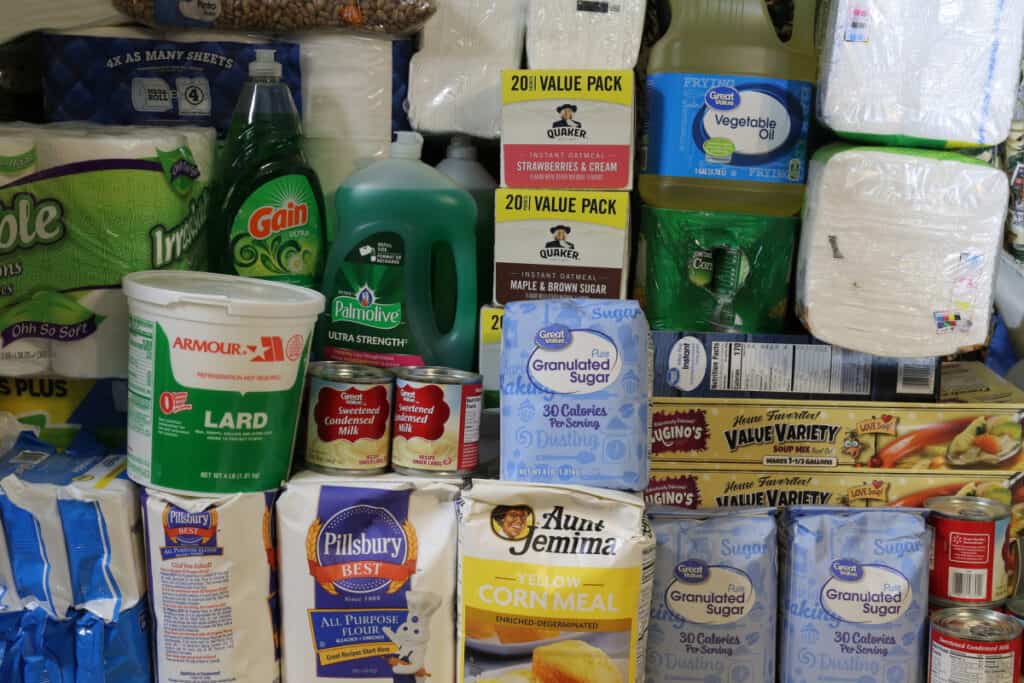
Canned Beans
Canned beans are another good option if dried beans aren’t available or you don’t want to have to soak them.
Look for:
- pinto beans (very versatile)
- black beans (higher in protein and fiber than pinto, although both are packed with nutrients)
- white beans (such as Great Northern or Cannellini)
Rice
This one’s a no-brainer for a hearty grocery staple, right?
I prefer brown rice for nutritional value. The Minute Rice brand has a shelf life of 2 years.
However, standard white rice lasts for 4-5 years!
So if you’re stashing away a long-term emergency reserve, the white rice would be your best option.
Frozen Fruits and Veggies
We like to keep frozen blueberries, strawberries and pineapple on hand because they go farther and usually cost less than other frozen fruits.
Plus they make great smoothies, ice cream toppings or pie filling.
For frozen veggies, the larger bags are generally a better deal.
Think basic: green beans, vegetable medleys (for soups, stews and chicken pot pie), peas (can add to cold pastas too).
Or, stock up on whichever veggies your kids will eat!
Frozen stir-fry veggie blends are another great staple to keep on hand.
You can serve them stand-alone or with rice.
This list of quick dinners can be made without a detailed recipe!
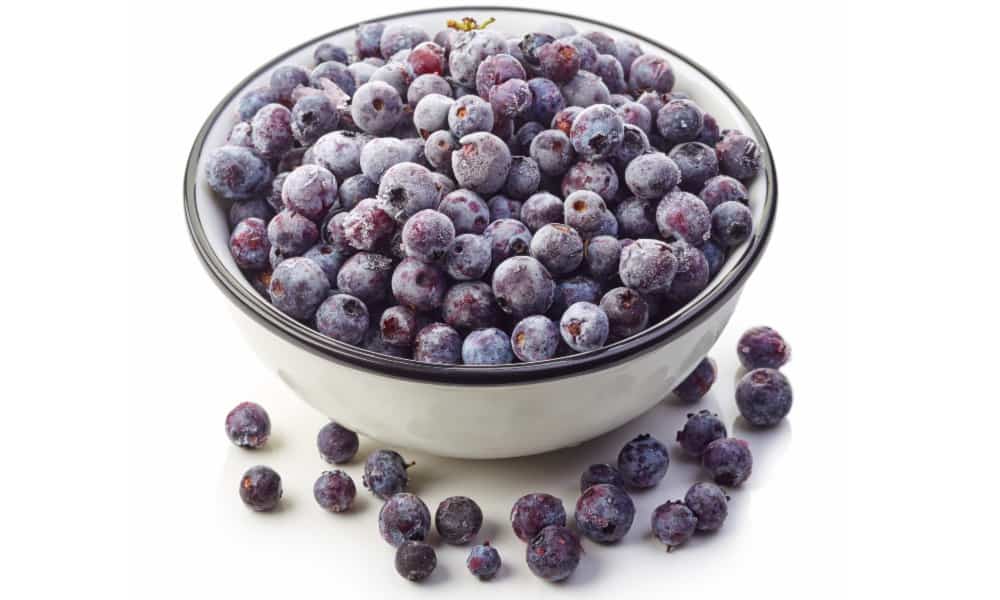
Canned/Packaged Fruits and Veggies
Our favorite picks for fruits that last – and best buys in my area:
- Applesauce
- Large cans of peach slices
- Fruit leather strips
Applesauce in the jar is also great to have around because it can substitute for eggs in some baking recipes.
We like Welch’s Naturals jelly for our PB&J sandwiches. It comes in a plastic container (great for clumsy kids), and contains real sugar instead of corn syrup.
For veggies, as with frozen variety, I like to choose what I know my kids will eat.
For us, that’s green beans, corn, and carrots.
Choose the lower-sodium options if you can, or consider rinsing your veggies before cooking them.
I also like to have extra diced tomatoes on hand for things like casseroles, chili, soups or in omelets.
Potatoes
Potatoes can last a few months in the fridge, or up to a year in the freezer (cook and mash first).
Thicker-skinned potatoes like Russet potatoes typically last the longest.
For long-term storage, dried potato flakes are the best option.
Stored properly, experts say potato flakes can last up to 30 years.
(Try vacuum sealing in mylar bags for best results.)
Garlic
Unpeeled garlic can last several months (or longer) in the fridge.
But I also like to keep jarred garlic, preserved in oil for the pantry.
It’s just an easy way to flavor a variety of meat dishes. That is- if you like garlic.
Canned / Preserved Meats
Canned chicken, while not the healthiest option, does deliver protein.
It never hurts to have a few cans on-hand in case the power goes out for some reason.
Canned tuna is a good source of omega-3s and a frugal source of protein.
Most brands are shelf-stable for 3-4 years.
Dry summer sausage is another no-cook staple that you can keep in your freezer for 8-10 months unopened, or 6 months in the fridge.
Beef jerky is another option, though it tends to be higher priced unless you make your own.
Frozen Meats
As a large(ish) family, I go for frozen meats (or meats I can easily freeze) that are versatile and those I know I can stretch the farthest.
For us, that’s ground beef, ground pork, bacon, and boneless/skinless chicken breasts or chicken tenders.

I also buy a few whole chickens each month as we can get about 3 meals from a 5-pound bird.
I typically make my easy whole chicken recipe, then chicken and noodles, then homemade chicken stock.
Experts suggest that ground beef and other ground meats will start to lose their flavor after 4-12 months in the freezer.
Chicken pieces typically last around 9 months to a year.
But, if kept at 0 degrees or below these meats can last indefinitely. (See this chart for quality recommendations.)
Have you ever ordered meat online?
Read this post for my full review of ButcherBox: high quality frozen meats delivered to your doorstep.
Chicken, Beef, Vegetable Stocks
It’s always nice to have a few cans of stock for soup bases and roasts, in case you don’t have any bone-in meats to make your own.
My personal favorite is Better than Buillon chicken and beef base.
Regular-ol’ chicken or beef buillon cubes is another option with a long shelf life.
Deli Meats
Deli meats like ham and turkey make fairly inexpensive meals to throw together.
You can also freeze lunch meats for around 1-2 months, if needed.
Cheeses
Many of the recipes my family likes involve cheddar or mozzarella cheese, so those are the two I look for on sale.
I prefer block over pre-shredded cheese because it melts better without the anti-caking ingredients that are added to shredded varieties.
Another idea is to shred your blocks before freezing, though.
Grated Parmesan is also a good choice to have on hand, and lasts around 10-12 months in the fridge or up to 18 months in the freezer.
We like this brand.
Milk
When I’m near an Aldi, I will sometimes stock up on their milk because of their great prices.
You can freeze milk and thaw it out in cold water or in the fridge. It will last around 3 months in the freezer.
Pro tip:
Milk will expand as it freezes, so be sure to pour out the top one-fifth from the container before freezing.
Just pour it into an already-opened container in your fridge.
Of course, if your power goes out – or to save precious freezer space, you can also buy some powdered milk.
Most people like it better for cooking than drinking, but it’s definitely something to keep on hand.
Non-fat instant milk powder lasts longer than whole milk powder.
This brand comes highly recommended by food prepping experts and we’ve found it is the best tasting, too.
Butter
We are huge fans of butter around here, and this is something I will stock up on every time it’s on sale.
You can keep butter in the freezer for around around a year.
Spices
My most used spices are:
- Italian seasoning (for my rustic french bread, and pasta dishes)
- garlic powder
- onion powder
- cinnamon
- chili powder
- paprika
- cumin (make your own taco seasoning).
Cooking oils
Vegetable oil is not the healthiest oil, but it is a versatile staple for baking and frying foods, and it’s one of the cheapest cooking oils.
I also like to keep light olive oil on hand as a healthier option.
Flour
From cookies to cakes, sandwich bread, hamburger buns to dinner rolls to gravy- you’re going to need all-purpose flour!
Sure, you can buy canned or frozen breads, but when you’re in a pinch you can whip up your own.
Our Thrifty Homemade Sandwich Bread is a frugal recipe to make (and it has 1,000s of successful reviews on Pinterest!).
Many reviewers have actually been able to get two loaves from the recipe.
You can also make your own crackers with flour, butter and a few other ingredients. (Here’s an easy recipe!)
Old-fashioned Rolled Oats
Not as fancy as their steel-cut competitors, but easier on the wallet.
I always have a healthy supply of old-fashioned oats for breakfast, for baking cookies, and homemade granola bars, etc.
Bulk buying tip:
If you’re interested in buying larger quantities for long-term storage, check out Azure Standard.
I order from Azure and do a local pickup a few times a year to save money on things like oats, flour, sugar, vanilla and so much more.
Baking Yeast, Baking Soda and Baking Powder
I usually buy active dry yeast in bulk from the health food store for the best value.
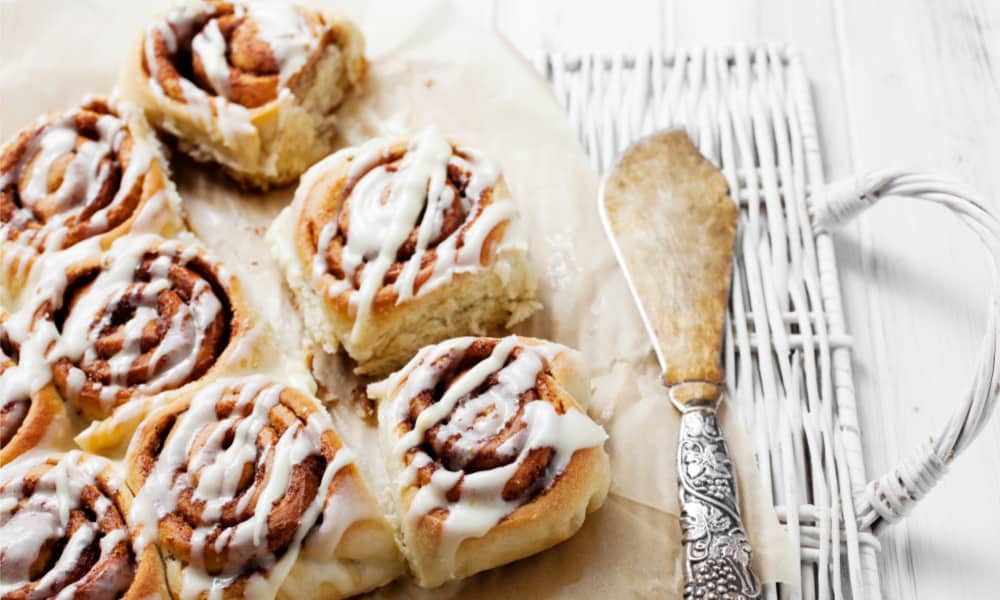
Store it in a glass mason jar in the freezer and it will last around a year to 18 months.
Don’t forget to keep a stash of extra baking soda and baking powder, for quick breads and cookies.
If you have opened boxes in the cabinet, they can lose their effectiveness in just a few months.
Sea Salt
Sea salt is said to be minimally processed in comparison to regular table salt.
(Plus has many other health benefits).
You can find varieties that do contain iodine now, as well.
I like this one which you can typically find at Walmart for just a few dollars.
Sugar
Basic baking staples can become scarce if an emergency arises, and sugar is no exception.
It never hurts to have a few extra bags on hand.
I prefer C&H brand as it comes from pure sugar cane and not sugar beets.
(If it doesn’t say “cane sugar”, it’s from sugar beets.)
Brown sugar is also a must-have for most cookie recipes, and I consider it an overlooked grocery staple.
Chocolate chips
Other than for the obvious reasons (cookies!), chocolate chips are an easy sweet snack to ration after dinner.
Personally I love the dark chocolate chips for snacking.
But I also stock up on mini chocolate chips for making these energy balls for the kids (and me!).
My friend Katie got me hooked on her healthy yogurt cup recipe and now I’m adding chocolate chips to my yogurt all the time.
I mean, why not? 😉
Honey
Honey is something many people neglect on their grocery staples checklist.
Raw, local honey is your best bet for nutritional value, as many store-bought brands have fillers.
The biggest reason to stock up on honey?
If stored properly, it can last for many years. Just know that many experts recommend a shelf life of around 2 years because it can become contaminated, especially once it’s opened.
Maple syrup
Maple syrup is another healthy sugar substitute.
I usually buy ours from Sam’s Club and use it for homemade pancakes and other snacks.
Coffee and Creamer
This one’s for all the moms!
Or anyone who relies just a little on daily caffeine intake.
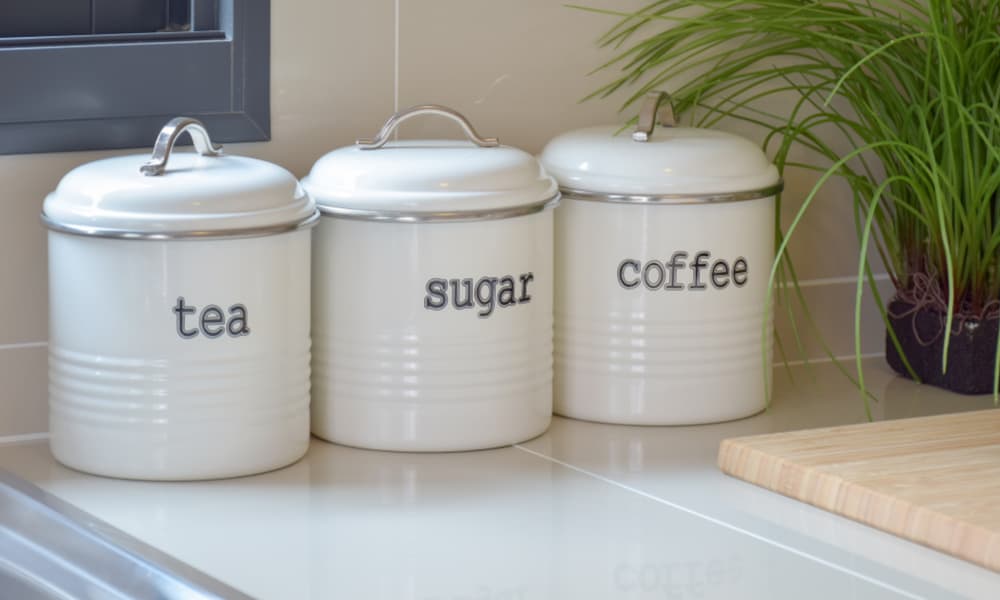
Powdered creamer can last for several months.
Liquid creamers that don’t require refrigeration will usually last just a month or two (check the date on the individual containers.)
This type of single-serve coffee maker is what we have and love, because you can use either ground coffee or coffee pods, whichever you have on hand.
Trail mix / Nuts/ Raisins
Sometimes pre-mixed trail mixes can be just as affordable as making them yourself, depending what ingredients you choose.
Look for varieties with dried fruit and almonds versus chocolate-loaded varieties.
(Or, you know, get both to balance things out!)
We also love to snack on walnuts and add them to cookies and banana bread recipes.
Read next: 15+ Cheap Lunch Options for Kids
Popcorn kernels
Popping your own popcorn is cheaper and healthier than the individually-bagged type.
Orville Reddenbacher’s, for whatever reason, pops the most consistently in our experience!
We use one of the new-fangled silicone microwave popcorn makers like this one for movie nights.
Just add a little cooking oil and it’s ready in less than 2-1/2 minutes.
Dried pasta
Spaghetti, Penne, bowties and elbow noodles are all cheap and versatile grocery staples we try to keep on hand.
Pasta is, of course, always a hit with kids.
Tomato Sauces
Basic spaghetti sauce can be used for all types of pasta, as a pizza sauce (make mini pizza’s with cheap refrigerated biscuits!), and for homemade sloppy joes.
Tomato sauce and tomato paste can be used for chili, soups, in beef roast, or as an alternative to spaghetti sauce in a pinch (add Italian seasoning).
If your family likes pastas, casseroles, or soups, your grocery staples should include a healthy supply of tomato products in general.
Condiments
Mayo and ketchup are two that my kids enjoy and are hard to substitute for.
Italian dressing is another go-to condiment.
I use it for marinating chicken breasts and other meats and for adding to cold pasta dishes with some fresh veggies.
Grocery staples save the day!
When it comes to choosing pantry and freezer essentials, each family’s needs and preferences are going to be a little different.
The idea is to come up with your own frequently-used grocery staples – those items you wouldn’t want to be without for an extended time.
But if you take this list as a starting point and stock up on a reasonable amount for your family size, you could start shopping MUCH much less frequently.
Not only that, you’ll be prepared to make most basic meals and snacks from scratch, if you ever needed to.
Printable Shopping List + More
Take advantage of our full Money-Saving Meal Planner for a printable version of this list of common grocery staples, plus much more!
You might also like:
Easy Sandwich Bread Recipe (for pennies)
Better than Rotisserie -Roasted Chicken Recipe
Energy Ball Snack (healthy snack for kids)
How to Meal Plan -Beginner’s Guide
Why Homemaking is Always an Essential Skill
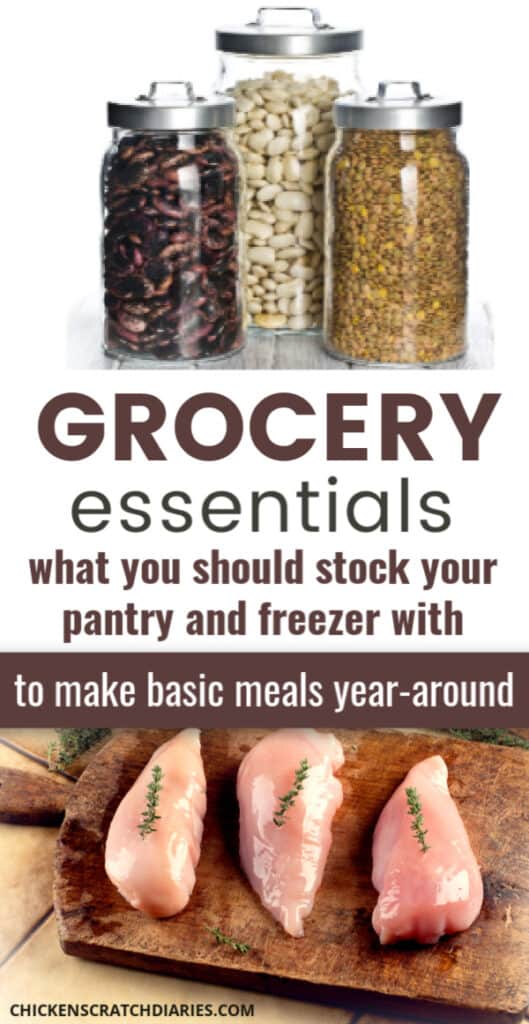

THANK YOU FOR SHARING I USED TO BUY IN BULK WHEN RAISING MY 5 CHILDREN THEY ARE IN THEIR LATE 30’S AND MIDDLE 40’S I HAVE SINCE GOTTEN AWAY FOR BEING WELL STOCKED UP I STILL STOCK UP TO A CERTAIN DEGREE BUT RECENT EVENTS HAVE REAWAKENED MY NEED TO STOCK UP. YOUR RECIPES WILL BE A GREAT HELP. MAY GOD BLESS YOU GREATLY, KEEP YOU SAFE AS WELL AS MEET YOUR DAILY NEEDS.
You’re very welcome, Pamela – and God bless!
This is a helpful list of items! With fall and winter coming up, I need to be stocking up more!
Me too Kristin!
Super tips! One of the things I’ve loved about stocking up is not having to run to the store when I discover I’m out of something essential.
It can now wait until the next trip b/c we generally have an extra on hand.
Oh yes! It’s wonderful when you can stretch out those store runs, especially now 🙂